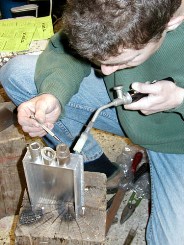Categories: Sharing experience, Electrician Secrets
Number of views: 68182
Comments on the article: 2
Folk aluminum soldering tips
 The problems associated with brazing aluminum are explained by the fact that the surface of this metal is covered with a thin, flexible and very strong oxide film - Al2O3. It is not possible to remove it by mechanical methods, because when a clean surface of aluminum comes into contact with air or water, it instantly again becomes covered with an oxide film. Conventional fluxes do not dissolve oxide.
The problems associated with brazing aluminum are explained by the fact that the surface of this metal is covered with a thin, flexible and very strong oxide film - Al2O3. It is not possible to remove it by mechanical methods, because when a clean surface of aluminum comes into contact with air or water, it instantly again becomes covered with an oxide film. Conventional fluxes do not dissolve oxide.
For mechanical cleaning of oxide, it is recommended to clean the surface under a film of oil, but in this case, the oil should be completely dehydrated, for which it needs to be heated for some time at a temperature of 150-200 ° C.
It is recommended to use mineral oils, preferably vacuum VM-1, VM-4.
There are tips for using rifle alkaline oil for this purpose, how effective it is is difficult to say, because probably if the oil contains alkali, then water too. There are soldering irons in which a steel scraper is mounted on the sting for cleaning.
It is also proposed to clean the surface with coarse iron filings, which are rubbed over the surface under a layer of oil or rosin with a soldering iron tip, solder, sawdust here act as an abrasive, tinning occurs at the same time, I tried this method, the connection is weak, apparently due to spot tinning aluminum.
Probably a more reliable soldering can be obtained by tinning aluminum over a sublayer of copper electrolytically deposited on the surface of aluminum. Perhaps, for the same purpose, a sublayer of zinc can be used, which is applied in the same way as in the aluminum chromium recipe. More reliably, the oxide film is removed using special active fluxes.
It is also good to combine mechanical surface treatment with the use of active fluxes.
The following are some flux recipes.
1. Oleic acid - 20 g. Lithium iodide (LiI) 2-3 g. Chemistry and Life, 11/1988, p. 78
2. Zinc chloride (ZnCl2) 85% 90% 95% Ammonium chloride (NH4Cl) 10% 8% - Sodium fluoride (NaF) 5% 2% 5%
3. Sodium chloride (NaCl) 6.5% Sodium sulfate (Na2SO4) 4% Lithium chloride (LiCl) 23.5% Potassium chloride (KCl) 56% Cryolite (Na3AlF6) 10%
4. Flux F59A Cadmium borofluoride (Cd [BF4] 2) 10% Zinc borofluoride (Zn [BF4] 2) 3% Ammonium borftride (NH4BF4) 5% Triethanolamine 82%
5. Sodium fluoride (NaF) 10% Zinc chloride (ZnCl2) 3% Lithium chloride (LiCl) 5% Potassium chloride (KCl) 82%
6. ... To the well-known methods of brazing aluminum, I propose to add another, very simple. The cleaned and fat-free soldering place is covered with a soldering iron with a thin layer of rosin, and then immediately rubbed with a tablet of analgin (benalgin). After that, the surface is treated with POS-50 solder (or close to it), pressing the tip of a slightly overheated soldering iron to it with little effort. The residual flux is washed off from the tinned place with acetone, warmed up again carefully and the flux is washed off again. Soldering parts is carried out in the usual way.
A. GLOTOV p. Galievka, Voronezh region (Radio 5-86, p. 37)
7. An excerpt from a book about soldering aluminum wires with a copper method of immersion in a bath with solder. The following is a description of the operations for making connections.
From the ends of the coils, the enamel insulation is removed from the aluminum wire over a length of 60-70 mm, from the ends of the copper wires the braid and rubber insulation are removed over a length of 35-40 mm, the bare wires are stripped to a shine.
Enamel removal from wires with a diameter of up to 1 mm is carried out with a knife, from wires with a diameter of more than 1 mm - with metal brushes rotating towards each other. These brushes with a diameter of 250-300 mm are drawn from steel wires with a diameter of 0.08-0.1 mm protruding from the mandrel to a length of 50-60 mm; each brush is rotated by a 0.6 kW electric motor with a rotation speed of 3,000 rpm. The final cleaning is done with a glass grinding sand.
The cleaned ends are thoroughly wiped with a calico swab moistened with acetone or gasoline. The interval between stripping and tinning or welding should not exceed 2-3 hours.
All the stripped ends of the wires are tinned, with the exception of those welded by contact heating. The ends of aluminum coils are dipped into a bath with a F59A flux, and the ends of copper wires (leads) with a KSp flux. Then the ends are immersed in a bath with molten solder P250A with a temperature of 310-320 ° C or P300A with a temperature of 370-380 ° C for 3-10 seconds until the cessation of steam and smoke.
The served ends are shaken off to remove excess solder, no later than 1-1.5 hours later they are cleaned with a hair brush of the residues of flux F59A, washed first in hot running water, then in cold running water and wiped dry with a clean calico swab. Residues of KCp flux after tinning are not removed. It is best to solder aluminum using a special ultrasonic soldering iron.
See also article about the use of solder fat.
See also at bgv.electricianexp.com
:
